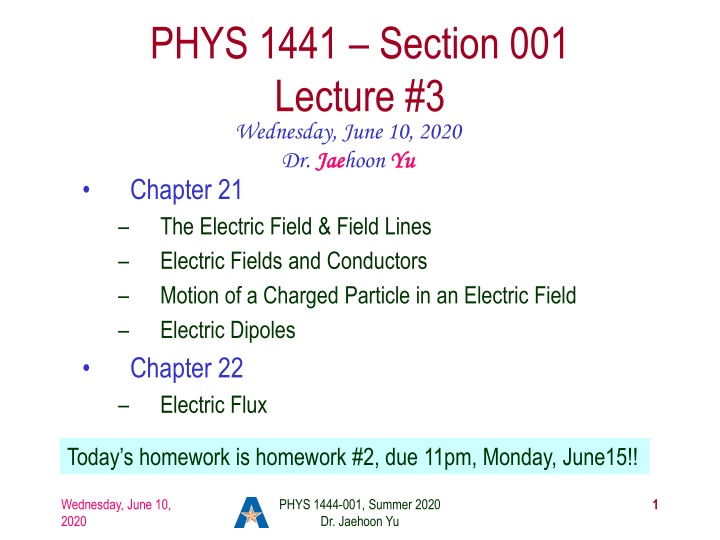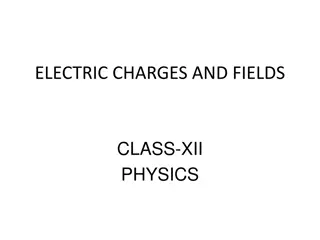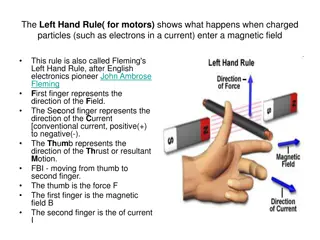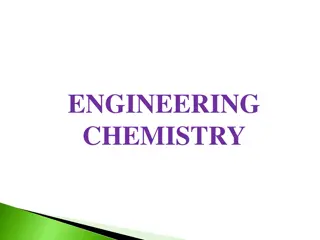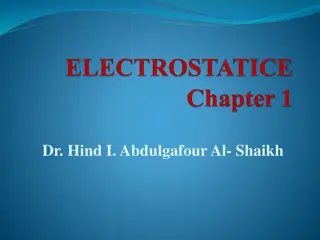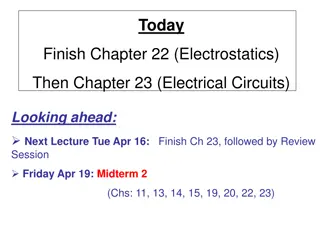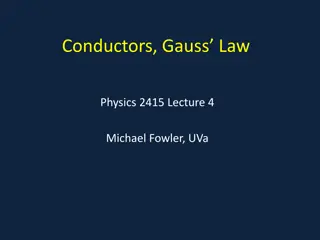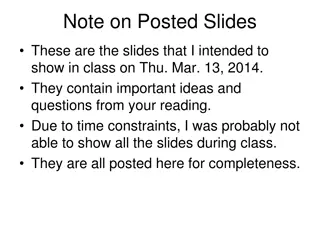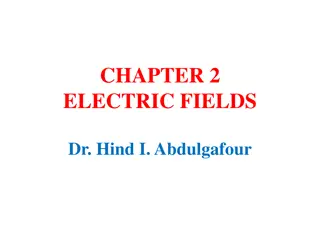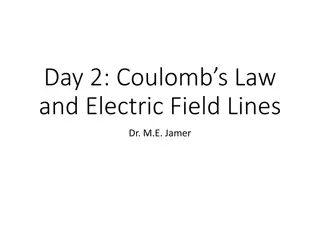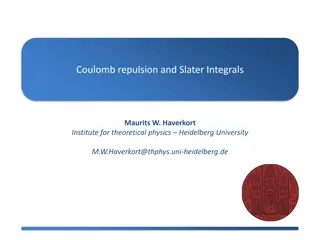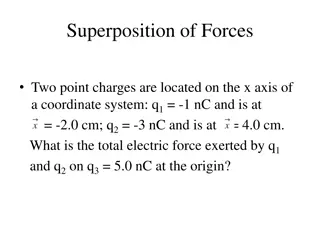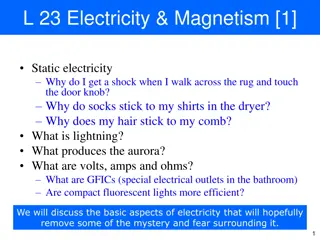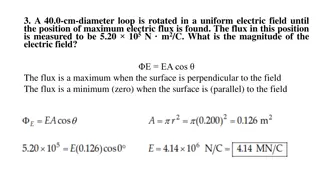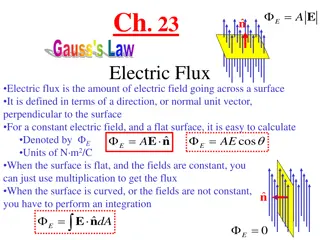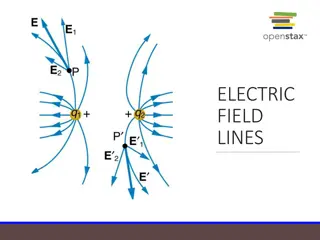Electric Fields, Conductors, and Coulomb's Law Overview
key concepts in physics including electric fields, conductors, motion of charged particles, electric dipoles, and Coulomb's Law. Get details about homework submissions, upcoming exams, and extra credit projects. Understand the comparison between Coulomb force and gravitational force in different scenarios. Discover the unit, formula, and characteristics of Coulomb force as a vector quantity. Enhance your understanding of electric phenomena with valuable information shared by Dr. Jaehoon Yu.
Download Presentation

Please find below an Image/Link to download the presentation.
The content on the website is provided AS IS for your information and personal use only. It may not be sold, licensed, or shared on other websites without obtaining consent from the author.If you encounter any issues during the download, it is possible that the publisher has removed the file from their server.
You are allowed to download the files provided on this website for personal or commercial use, subject to the condition that they are used lawfully. All files are the property of their respective owners.
The content on the website is provided AS IS for your information and personal use only. It may not be sold, licensed, or shared on other websites without obtaining consent from the author.
E N D
Presentation Transcript
PHYS 1441 Section 001 Lecture #3 Wednesday, June 10, 2020 Dr. Jae Jaehoon Yu Chapter 21 The Electric Field & Field Lines Electric Fields and Conductors Motion of a Charged Particle in an Electric Field Electric Dipoles Chapter 22 Electric Flux Yu Today s homework is homework #2, due 11pm, Monday, June15!! Wednesday, June 10, 2020 PHYS 1444-001, Summer 2020 Dr. Jaehoon Yu 1
Announcements 44/48 of you have registered in the homework system. 35/44 submitted the homework! You MUST submit your answer to obtain 100% credit! Virtual Physics Clinic: (M: 9am 1pm, TuWTh: 9am 5pm) https://teams.microsoft.com/l/channel/19%3ae5b118c00e8d4baa8c0b2b4be09bbcd5%40thread.tac v2/General?groupId=a272a438-e2fd-42e7-8c18-1a8166647940&tenantId=5cdc5b43-d7be-4caa- 8173-729e3b0a62d9 Term Exam 1 In class, coming Monday, June 15: DO NOT MISS THE EXAM! CH21.1 to what we learn on tomorrow, Thursday, June 11 + Appendices A1 A8 BYOF: You may bring a one 8.5x11.5 sheet (front and back) of handwritten formulae and values of constants for the exam No derivations, word definitions or setups or solutions of any problems! No additional formulae or values of constants will be provided! Must send me the photos of front and back of the formula sheet, including the blank, no later than 10am Monday morning Once submitted, you cannot change, unless I ask you to delete some part of the sheet! Wednesday, June 10, 2020 PHYS 1444-001, Summer 2020 Dr. Jaehoon Yu 2
Reminder: Extra Credit Special Project #1 Compare the Coulomb force to the Gravitational force in the following cases by expressing Coulomb force (FC) in terms of the gravitational force (FG) Between the two protons separated by 1m Between the two protons separated by an arbitrary distance R Between the two electrons separated by 1m Between the two electrons separated by an arbitrary distance R Five points each, totaling 20 points BE SURE to show all the details of your own work, including all formulae, proper references to them and explanations Must be handwritten and submit all pages in a single PDF file File name must be: SP1-First-Last-summer20.pdf Due at the beginning of the class Monday, June 15 Wednesday, June 10, 2020 PHYS 1444-001, Summer 2020 Dr. Jaehoon Yu 3
Coulombs Law The Formula Q Formula r QQ Q Q Q 2 = 1 r 2 1 2 2 F 1 F k 2 Is Coulomb force a scalar quantity or a vector quantity? Unit? A vector quantity. The unit is Newtons (N)! The direction of electric (Coulomb) force is always along the straight line joining the two objects. If the two charges are the same: forces are directed away from each other. If the two charges are the opposite: forces are directed toward each other. Coulomb force is precise to 1 part in 1016. Unit of charge is called Coulomb, C, in SI. The value of the proportionality constant, k, in SI unit is Thus, 1C is the charge that gives F~9x109N of 9 2 2 = 8.988 10 N m k C Wednesday, June 10, 2020 force when placed 1m apart from each other. PHYS 1444-001, Summer 2020 Dr. Jaehoon Yu 4
The Elementary Charge and Permittivity The elementary charge, the smallest unit charge, is that of an electron: Since electron is a negatively charged particle, its charge is e. Object cannot gain or lose fraction of an electron. Electric charge is quantized. Charge of an object changes always in an integer multiples of e. What kind of quantity is the electric charge? The proportionality constant k is often written in terms of another constant, 0, the permittivity* of free space. They are related and . Thus the electric force can also be written as: Note that this force is for point charges at rest. *Mirriam-Webster, Permittivity: The ability of a material to store electric potential energy under the influence of an electric field 19 = 1.602 10 e C Scalar!! = 1 4 k 12 2 2 QQ r = = N m 1 4 1 4 8.85 10 k C 0 0 = 1 2 F 2 0 Wednesday, June 10, 2020 PHYS 1444-001, Summer 2020 Dr. Jaehoon Yu 5
Example 21 1 Which charge exerts a greater force? Two positive point charges, Q1=50 C and Q2=1 C, are separated by a distance L. Which is larger in magnitude, the force that Q1 exerts on Q2 or the force that Q2 exerts on Q1? QQ = 1 L 2 F k What is the force that Q1 exerts on Q2? 12 2 Q Q = 2 L 1 What is the force that Q2 exerts on Q1? F k 21 2 Therefore the magnitudes of the two forces are identical!! Well then what is different? The direction. Which direction? Opposite to each other! What is this law? Newton s third law, the law of action and reaction!! Wednesday, June 10, 2020 PHYS 1444-001, Summer 2020 Dr. Jaehoon Yu 6
Example on the Coulomb Force Electric force on electron by proton. Determine the magnitude of the electric force on the electron of a hydrogen atom exerted by the single proton (Q2=+e) that is its nucleus. Assume the electron orbits the proton at its average distance of r=0.53x10-10m. What is the orbital speed of the electron (me=9.12x10-31kg)? 1 4 QQ QQ = = 1 r 2 1 r 2 F k Using Coulomb s law 2 2 0 19 19 = = = + = Each charge is 1.602 10 1.602 10 Q e C Q e C and 1 2 So the magnitude of the force is ( )( ) 19 19 1.6 10 1.6 10 C C Q Q 9 2 2 = 9.0 10 N m = C 1 r 2 F k ( ) 2 2 10 0.53 10 m 8 = 8.2 10 N Which direction? Toward each other Orbital speed of the election? Wednesday, June 10, 2020 PHYS 1444-001, Summer 2020 Dr. Jaehoon Yu 7
Vector Additions and Subtractions Addition: Triangular Method: One can add vectors by connecting the head of one vector to the tail of the other (head-to-tail) Parallelogram method: Connect the tails of the two vectors and extend Addition is commutative: Changing order of operation does not affect the results A+B=B+A, A+B+C+D+E=E+C+A+B+D A B = A+B A+B A+B OR B B A A Subtraction: The same as adding a negative vector:A - B = A + (-B) A -B Since subtraction is equivalent to adding a negative vector, subtraction is also commutative!!! A-B Multiplication by a scalar is increasing the magnitude A, B=2A A A 2 = A B=2A Wednesday, June 10, 2020 B B PHYS 1444-001, Summer 2020 Dr. Jaehoon Yu 8
Example for Vector Addition A force of 20.0N applies to north while another force of 35.0N applies in the direction 60.0o west of north. Find the magnitude and direction of resultant force. ( ) ( ) 2+ F2sin60 2 F = = F1+ F2cos60 N F2sin 2cos260 +sin260 ( 2+ F2 ( ) ( 35 0 . 20 + 2325 = 48.2(N) )+ 2F1F2cos60 2+ F2 F1 F2 = 2+ 2F1F2cos60 F2cos F1 ) 2 2 = = + 0 . 2 20 0 . 35 0 . cos 60 20 F1 F F2 sin60 F1 + F2 cos60 E Find other ways to solve this problem q = tan-1 35 0 . + sin 60 = 1 tan 20 30 0 . 3 . 35 0 . cos 60 = = 1 tan 38 9 . W wrt to N 37 5 . Wednesday, June 10, 2020 PHYS 1444-001, Summer 2020 Dr. Jaehoon Yu 9
Components and Unit Vectors Coordinate systems are useful in expressing vectors in their components y (+,+) Fy Fx= Fy= }Components (Fx,Fy) F (-,+) x } Magnitude F = 2+ Fy 2 (-,-) (+,-) Fx Fx Wednesday, June 10, 2020 PHYS 1444-001, Summer 2020 Dr. Jaehoon Yu 10
Unit Vectors A unit vector is the vector that indicates only the directions of the components Dimensionless Magnitudes are exactly 1 Unit vectors are usually expressed in i, j, k or ( preferred method in this class!) So the vector F can be re-written as Fx+ Fy Wednesday, June 10, 2020 PHYS 1444-001, Summer 2020 Dr. Jaehoon Yu 11
Examples of Vector Operations Find the resultant force which is the sum of F1=(2.0i+2.0j)N and F2 =(2.0i-4.0j)N. ( ) ( ) 2+ -2.0 2 tan-1F3y 4.0 1 2.0 4.0 = = o = tan 27 F3x = 16+4.0 = 20 = 4.5(N) Find the resultant force of the sum of three forces: F1=(15i+30j +12k)N, F2=(23i+14j -5.0k)N, and F3=(-13i+15j)N. 25 ( ) ( ) ( ) 2+ 59 2+ 7.0 2=65(N) Magnitude Wednesday, June 10, 2020 PHYS 1444-001, Summer 2020 Dr. Jaehoon Yu 12
Example 21.2 Three charges on a line. Three charged particles are arranged in a line as shown in the figure. Calculate the net electrostatic force on particle 3 (the -4 C on the right) due to other two charges. What is the force that Q1 exerts on Q3? = kQ1Q3 L2 ( )-4.0 10-6C 0.5m ( )-4.0 10-6C 0.2m ( ( )-8.0 10-6C ( ) 9.0 109N m2C2 F13x = =1.2N ) 2 What is the force that Q2 exerts on Q3? ( ( )3.0 10-6C ( ) 9.0 109N m2C2 = kQ2Q3 F23x = = -2.7N ) 2 L2 Using the vector sum of the two forces Fx= F13x+ F23x=1.2+ -2.7 F = -1.5i(N) ( ) ( )= -1.5 N ( ) Fy= 0 N Wednesday, June 10, 2020 PHYS 1444-001, Summer 2020 Dr. Jaehoon Yu 13
